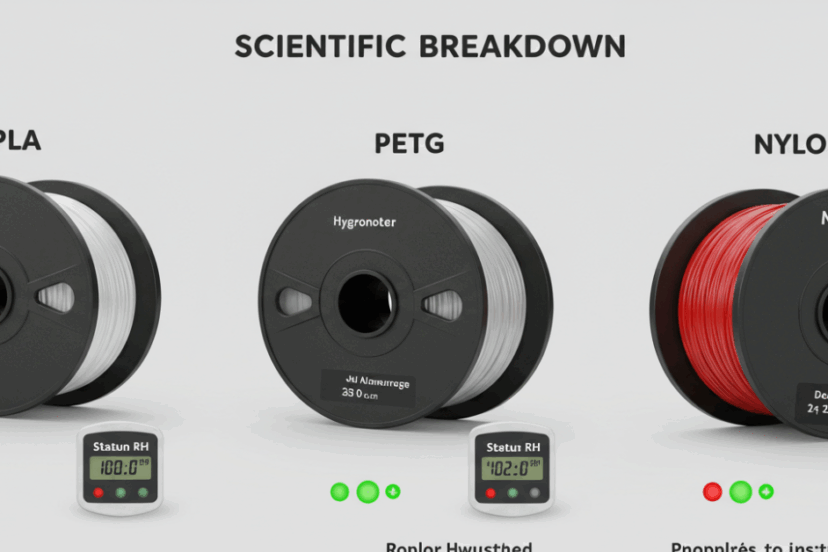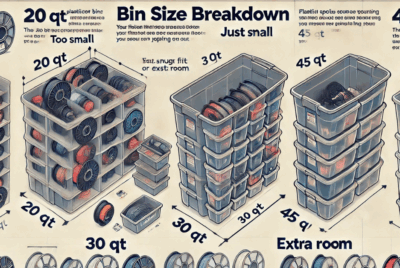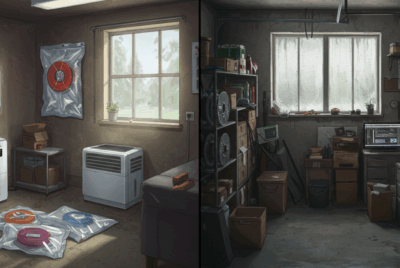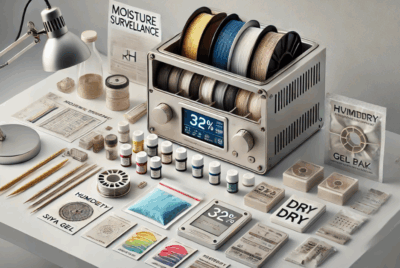What’s the ideal humidity level for filament storage?
1. Moisture Is the Silent Filament Killer
You might not see it. You might not even feel it.
But moisture in the air is quietly sneaking into your filament—ruining prints and wasting money.
And it all comes down to one thing: humidity.
Let’s figure out the ideal humidity level for storing 3D printer filament, so you can protect your spools and print with confidence.
2. Why Humidity Control Is Essential for 3D Printing
3D printing filament is hygroscopic, meaning it absorbs water from the air.
Too much humidity =
- Popping noises while printing
- Weak layer adhesion
- Surface blobs and stringing
- Failed or brittle prints
Once absorbed, that moisture must be baked out—and that’s time-consuming. Prevention is easier than correction.
3. What Is Relative Humidity (RH)?
Relative Humidity (RH) is a percentage that tells you how much moisture is in the air compared to the max it could hold at a given temperature.
- 0% RH = bone dry
- 100% RH = raining indoors 😅
For filament storage, we want RH low enough to keep spools dry, but not so dry that you over-engineer your setup.
4. What Happens When Humidity Gets Too High?
At high humidity levels, filament begins to:
- Absorb water
- Swell or become sticky
- Lose surface finish quality
- Cause uneven extrusion and layer lines
- Eventually become unusable without drying
You’ll notice your printer starts acting up—even though it’s not the printer’s fault!
5. General Guidelines: Safe Humidity Ranges by Filament Type
| Filament Type | Ideal RH Range | Caution Above |
|---|---|---|
| PLA | 20–40% RH | 50% |
| ABS | 20–40% RH | 50% |
| PETG | 15–30% RH | 40% |
| TPU | 15–30% RH | 35% |
| Nylon | 10–20% RH | 25% |
| PVA | <15% RH | 20% |
| Polycarbonate | 10–20% RH | 25% |
The more sensitive the material, the lower the RH threshold.
6. How Moisture Sensitivity Varies by Material
| Sensitivity Level | Filament Types |
|---|---|
| Low | PLA, ABS |
| Moderate | PETG, TPU |
| High | Nylon, PC |
| Extreme | PVA, HIPS |
Even low-sensitivity filaments can degrade in storage if humidity stays high for days or weeks.
7. Why 40% RH Isn’t a Magic Number for Everyone
The commonly recommended “keep it under 40% RH” rule is a good general target, but:
- PETG, Nylon, and PVA need lower
- Dry climates may allow 30–35% RH easily
- In tropical or coastal regions, even 40% might be hard to maintain without a dryer
Knowing your filament and your environment helps you fine-tune storage.
8. Best Humidity Range for PLA, ABS, and PETG
- PLA: 30–40% RH is generally safe. Can sit out for a couple days before drying is needed.
- ABS: Similar to PLA but prefers cooler temps.
- PETG: Needs 20–30% RH for long-term storage. High humidity quickly ruins PETG prints.
If you’re printing in a humid area, keep PETG in a dry box between prints
.
9. Best Humidity Range for Nylon, TPU, and PVA
These materials are very moisture-sensitive.
- Nylon: 10–20% RH or lower. Even a few hours in humid air is enough to damage a spool.
- TPU: 15–30% RH. Can be gummy or stringy if exposed.
- PVA: Store below 15% RH. It can literally dissolve in high humidity.
If you use these regularly, a filament dryer is essential.
10. How to Measure Humidity in Your Filament Storage
Use a digital hygrometer—they’re cheap and accurate.
Stick one inside:
- Your airtight storage bin
- Dry box
- Vacuum bag (use external sensor)
- DIY container
If it’s reading over your target RH, it’s time to swap your silica gel or check for leaks.
11. How Fast Filament Absorbs Moisture at Different RH Levels
| RH Level | Time to Moisture Saturation (Nylon) |
|---|---|
| 20% RH | Several days |
| 40% RH | 12–24 hours |
| 60% RH | Just a few hours |
| 80% RH | Less than 1 hour |
💡 PLA, PETG, and TPU take longer—but they’ll still absorb enough to affect print quality.
12. Tools That Help Maintain Ideal Humidity
- Silica gel packets
- Vacuum sealers
- Airtight plastic bins with gaskets
- Filament dry boxes like the SUNLU S2 or PrintDry Pro
- Rechargeable dehumidifier canisters
Add a hygrometer to keep track over time!
13. Common Mistakes That Raise RH in Storage Bins
- Not sealing the lid completely
- Opening the bin too often
- Using weak or exhausted desiccants
- Leaving damp filament inside
- Storing bins near windows, vents, or heaters
Your filament will stay safe longer if your container stays closed and climate-controlled.
14. Best Practices for Keeping Humidity Stable
✅ Use color-changing silica gel
✅ Rotate older filament to the front
✅ Dry filament before storing it
✅ Don’t mix high-sensitivity filaments with casual-use ones
✅ Vacuum seal backups
These simple steps make all the difference for print reliability.
15. Final Thoughts: Know Your Zone, Know Your Filament
There’s no one-size-fits-all answer when it comes to ideal filament storage humidity.
But if you stick to this golden rule:
Keep RH under 40% for most filaments—under 20% for sensitive ones,
you’ll avoid the majority of moisture-related print problems.
Think of it like keeping snacks fresh—airtight, dry, and away from heat.
Your printer will thank you with smooth, consistent prints.
❓FAQs
- Can I store filament in a room with a dehumidifier?|Yes, but still use sealed containers. Room dehumidifiers help but aren’t precise enough alone.
- What’s the cheapest way to lower RH in a storage box?
Use silica gel packs or clay-based desiccants. Swap them monthly or recharge as needed. - Do I need to monitor RH if I live in a dry climate?
Yes. Even dry climates can experience RH spikes, especially indoors with temperature changes. - Will vacuum sealing remove all moisture?
No. It helps slow down moisture intake, but the filament inside must be dry before sealing. - How often should I check RH in my containers?
Once a month minimum. Weekly checks are best if using moisture-sensitive materials.




